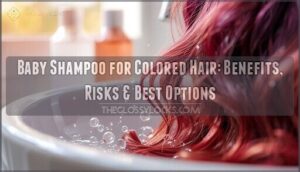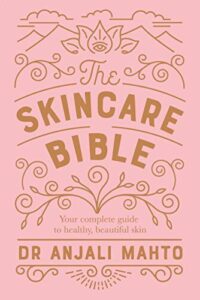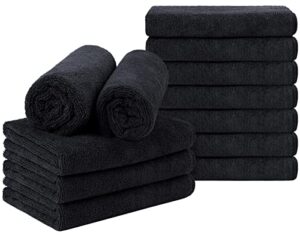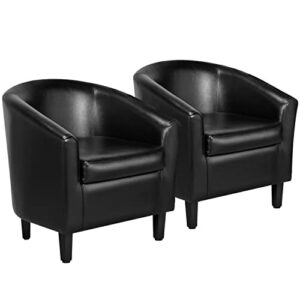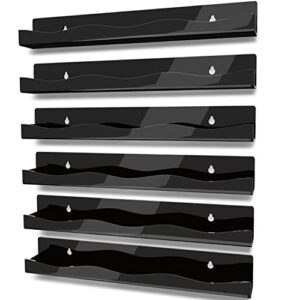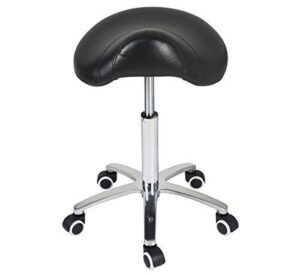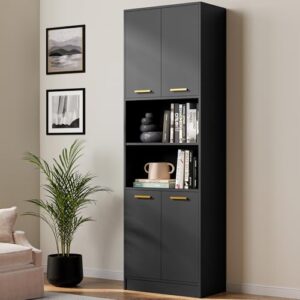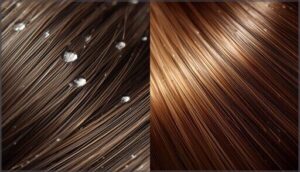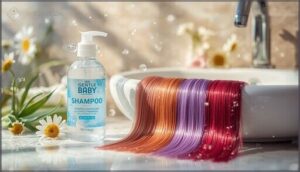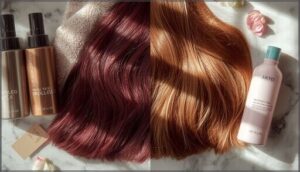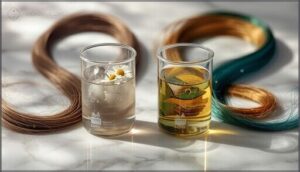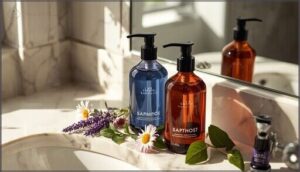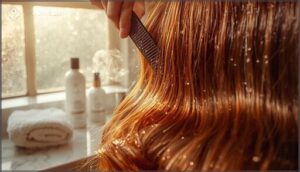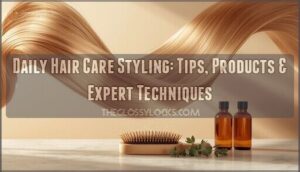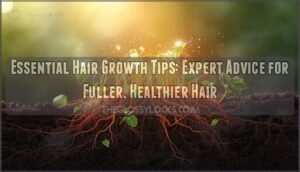This site is supported by our readers. We may earn a commission, at no cost to you, if you purchase through links.
You invested time and money perfecting your hair color, only to watch it fade after a few washes. The culprit? Often, it’s your shampoo. Many colorists hear the same question at the salon: “Can I use baby shampoo to protect my color?” The reasoning makes sense—baby formulas are gentle, sulfate-free, and designed for delicate skin.
But here’s the catch: baby shampoo wasn’t created with color-treated hair in mind. While it won’t damage your strands the way harsh sulfates do, it lacks the UV filters, antioxidants, and moisture-locking ingredients that keep your color vibrant.
Understanding which baby shampoos work best for colored hair—and when to skip them entirely—can mean the difference between color that glows for months and color that dulls within weeks.
Table Of Contents
- Key Takeaways
- Best Baby Shampoos for Colored Hair
- 1. Complete Skincare Guide Book
- 2. Soft Absorbent Microfiber Salon Hair Towels
- 3. Faux Leather Barrel Accent Chairs
- 4. Nail Polish Wall Mount Shelf
- 5. Ergonomic Saddle Stool Chair
- 6. Mid Century Modern Dining Chairs
- 7. Modern Salon Storage Station Furniture
- 8. Modern Salon Storage Cabinet
- 9. Cozy Castle Black Kitchen Pantry Cabinet
- 10. Modern Faux Leather Convertible Sofa
- Key Differences: Baby Vs. Color-Safe Shampoos
- Benefits of Baby Shampoo for Colored Hair
- Drawbacks of Using Baby Shampoo on Colored Hair
- Ingredients to Avoid and Seek Out
- How Baby Shampoo Affects Color Longevity
- When to Use Baby Shampoo on Colored Hair
- Alternatives to Baby Shampoo for Color Care
- Expert Tips for Maintaining Colored Hair
- Frequently Asked Questions (FAQs)
- Conclusion
Key Takeaways
- Baby shampoo lacks the UV filters, antioxidants, and color-locking ingredients found in professional formulas, which means it won’t actively protect your investment—though it won’t strip color as aggressively as sulfate-heavy shampoos.
- The higher pH of baby shampoo (around 6-7 versus the ideal 4.5-5.5 for colored hair) opens your cuticle and accelerates color fading by 40-50%, making it a poor choice for long-term color preservation.
- Sulfate-free, color-safe shampoos extend vibrancy up to 30% longer than baby formulas because they’re engineered with targeted moisture retention, pH balance, and protective polymers that lock pigment inside your strands.
- Reserve baby shampoo for occasional use when scalp sensitivity flares—2-3 times weekly at most—but invest in specialized color-protecting products for your regular routine if you want your shade to last months instead of weeks.
Best Baby Shampoos for Colored Hair
While baby shampoo wasn’t originally designed with color-treated hair in mind, some formulas work better than others when you’re trying to protect your shade. The key is finding products that offer gentle, sulfate-free cleansing without compromising your color investment.
Here are some top picks that balance mildness with the cleaning power your colored hair needs.
1. Complete Skincare Guide Book
You mightn’t think a skincare guide belongs in a discussion about colored hair, but understanding pH balance matters for both your complexion and your color-treated strands. Dr. Anjali Mahto’s science-backed approach to skin care tips mirrors the same principles you need for hair care for colored hair—prioritizing gentle cleansing and ingredient awareness.
While this beauty routine resource won’t directly address color protection or sulfate-free formulas, its emphasis on pH-balanced, natural remedies reinforces why colorsafe shampoo choices matter for maintaining your vibrant hues.
Best For: Anyone looking to understand the science behind skincare and build a personalized routine based on evidence rather than marketing hype.
- Written by a board-certified dermatologist who explains complex skincare science in plain, accessible language that anyone can understand.
- Covers a wide range of skin concerns from acne to aging, giving you practical advice for whatever you’re dealing with.
- Helps you separate genuinely effective products from overhyped gimmicks, potentially saving you money and frustration.
- Doesn’t include detailed citations for sources, which might leave some readers wanting more academic backup for the claims.
- Won’t satisfy readers looking for deep dives into skin biology or histology—it’s more practical than textbook-level.
- May feel too science-focused if you prefer holistic or alternative approaches to skincare.
2. Soft Absorbent Microfiber Salon Hair Towels
Protecting your color investment starts with the right towel. Traditional cotton towels create friction that damages your cuticle and accelerates fading, but microfiber towels absorb up to seven times their weight in water while reducing breakage by 43%.
That’s genuine color protection through gentle cleansing principles—less rubbing means your sulfate-free efforts aren’t undermined at the drying stage. These salon-quality tools complement your colorsafe shampoo routine, cutting drying time by 30–50% while maintaining salon hygiene standards.
For color-treated hair, microfiber care isn’t optional—it’s strategic.
Best For: Salon professionals and color-treated hair clients who want to protect their investment by reducing friction damage and cutting drying time without sacrificing absorbency.
- Absorbs up to 7 times their weight in water and reduces hair breakage by 43% compared to cotton towels, making them ideal for protecting color-treated and fragile hair.
- Cuts drying time by 30–50%, which means less heat styling damage and faster client turnover in salon settings.
- Lasts up to 6 times longer than cotton salon towels with proper care, saving approximately $50 per towel over its lifetime.
- Not bleach-proof, so they may fade or bleed color over time, limiting their use in salons with strict sanitation protocols.
- Actual lifespan averages only 80–150 washes before performance drops significantly, which is far below the advertised 500–1,000 wash claims.
- Requires gentle washing without high heat or harsh detergents, adding extra care requirements compared to standard cotton towels.
3. Faux Leather Barrel Accent Chairs
Your salon space shapes your color care routine more than you realize. Faux leather barrel accent chairs deliver ergonomic design features that support proper positioning during lengthy color treatments—critical when sulfate-free formulas require extended processing times.
Market trends show these chairs selling 1,072 units monthly at $193, driven by cost-effectiveness and environmental impact considerations versus genuine leather. While comfort issues affect 20.6% of users, their hypoallergenic surfaces align with gentle cleansing principles for colored hair care.
Strategic salon furniture isn’t luxury—it’s protecting your color investment through proper application positioning.
Best For: Budget-conscious shoppers looking for stylish, space-saving seating that works across multiple rooms—from living spaces to home offices—without the premium price tag of genuine leather.
- Cost-effective pricing under $200 makes them accessible, with sets of two available for under $400 and wholesale options dropping to $32 per unit for bulk buyers.
- Versatile design fits seamlessly in small spaces at 27.5″W x 25.5″D x 28″H, working equally well in bedrooms, cafes, and commercial venues.
- Lower environmental footprint during production compared to real leather, plus hypoallergenic surfaces that avoid animal-derived materials.
- Comfort issues reported by 20.6% of users, with chairs feeling firm and potentially heating up during extended use.
- Assembly difficulties affect 17.4% of buyers, and the low back design may not suit taller individuals.
- Not biodegradable—PU leather persists in landfills for hundreds of years, creating long-term plastic waste despite initial production savings.
4. Nail Polish Wall Mount Shelf
Your color-treated hair deserves organized care products—and wall-mounted nail polish shelves help you protect that investment. These acrylic storage solutions hold 15-20 bottles per layer across six tiers, freeing counter space while keeping sulfate-free, gentle hair care products visible and accessible.
With proper shelf installation using a 7/32-inch drill bit, you’ll categorize color protection treatments by formula type, ensuring your color preservation routine stays systematic. The acetone-resistant material withstands salon organization demands while supporting efficient retrieval of color-safe products during your wash-day routine.
Best For: Nail techs, salon owners, and nail polish enthusiasts who need space-saving vertical storage for collections of 90-120 bottles with easy color identification and quick access.
- Holds up to 120 bottles across six tiers with wavy line design for quick color sorting, freeing up valuable counter and drawer space in salons or at home.
- Acetone-resistant acrylic construction withstands salon chemicals and daily use while providing clear visibility of your entire collection at a glance.
- Takes under 5 minutes to install with basic tools and removable end stoppers keep bottles secure without slipping off during access.
- End caps may not mount securely according to some users, potentially requiring additional adhesive or alternative fastening methods.
- Limited to small items like standard nail polish bottles, so it won’t accommodate oversized bottles or other beauty products without modification.
- Some units arrive damaged or feel flimsy, and the shiny modern design may not suit all décor styles or preferences.
5. Ergonomic Saddle Stool Chair
When you’re applying baby shampoo to your colored hair, sitting in an ergonomic saddle seat reduces back strain during lengthy wash sessions. These adjustable height stools promote spinal alignment—especially vital when you’re leaning over sinks for sulfate-free color protection routines.
The saddle design encourages proper posture while you massage gentle formulas through your hair, minimizing lower back discomfort that can derail your hair care consistency. With back support that adapts from 21 to 28 inches, you’ll maintain the neutral lumbar position essential for comfortable, thorough cleansing.
Best For: Anyone who spends long hours sitting—whether you’re working at a desk, styling hair in a salon, or doing detailed tasks that require you to stay in one spot for extended periods.
- Saddle design keeps your spine in a natural position and reduces lower back pain, with studies showing it significantly lowers ergonomic risk compared to regular chairs.
- Adjustable height from 21 to 28 inches and smooth-rolling wheels make it easy to customize for different tasks and move around your workspace.
- Heavy-duty 400 lb weight capacity and thick cushioning provide stable, comfortable support that works across various settings from home offices to clinics.
- The non-breathable seat material can get uncomfortable and humid during long sitting sessions, especially in warmer environments.
- You might experience initial soreness in your hips and buttocks as your body adjusts to the saddle position, particularly if you have weak core muscles.
- The height adjustment lever can be stiff and awkward to use, and the rough edges on the base pose a risk of scraping your ankles if you’re not careful.
6. Mid Century Modern Dining Chairs
Your hair care routine deserves a comfortable setup—that’s where mid century chairs with ergonomic design come in. While you’re conditioning color treated hair with sulfate-free formulas, these sustainable materials provide the support you need during at-home treatments.
Modern dining tables paired with vintage furniture create a stable workspace for mixing gentle shampoo and organizing color protection products. The minimalist aesthetic won’t distract from your focus on maintaining vibrant, healthy hair care results between salon visits.
Best For: Anyone looking for stylish, comfortable dining chairs that work in multiple spaces—whether you’re setting up a modern dining room, need seating for a home office, or want affordable chairs that look great without breaking the bank.
- Thick, high-density cushions and ergonomic design make them comfortable for long dinners or work sessions, even if you’re tall or on the heavier side.
- Super easy to put together with clear instructions, and the sturdy four-point base with non-slip pads keeps them stable and quiet (as long as you tighten the legs now and then).
- The clean, modern look fits just about anywhere—dining rooms, kitchens, offices, or even covered patios—and the PU leather is easy to wipe down when things get messy.
- The white PU leather shows dirt pretty quickly, especially if you have kids or pets, and scratches from cat claws are a real risk.
- You’ll need to retighten the legs every so often to stop them from squeaking or wobbling.
- The backrest isn’t super sturdy if you like to lean back hard, so they’re better for upright sitting than lounging.
7. Modern Salon Storage Station Furniture
Professionals who color your hair need smart salon organization to protect their formulas and tools. Storage solutions with sophisticated cabinetry systems keep sulfate-free shampoos and gentle shampoo separated from harsh chemicals that threaten color protection and preservation.
Modern furniture design prioritizes space optimization—drawers designated for color-treated hair products stay organized, while upper shelves hold processing timers and foils. When your colorist works from well-arranged stations, they’re focused on your hair color results, not hunting for that critical color-protecting conditioner mid-application.
Best For: Professional salons and home users who need organized, space-saving storage for color-treated hair products, tools, and equipment in a modern setup.
- Large storage capacity with two-tier shelving, dual drawers, and cabinet space keeps color formulas, sulfate-free shampoos, and tools organized and easily accessible
- Durable MDF and ABS construction with smooth-sliding drawers and quiet-closing doors supports heavy daily use in busy salon environments
- Vertical design maximizes floor space while providing ample room for processing timers, foils, conditioners, and other color protection essentials
- Quality control issues reported by users, including incorrect piece markings, missing parts, and improperly cut wood that affects assembly
- Cabinet doors may not align correctly during installation, requiring adjustments or causing functionality problems
- Some customers have received incomplete or incorrect shipments, leading to frustration and potential delays in setup
8. Modern Salon Storage Cabinet
Your stylist’s equipment matters more than you might think. Salon cabinets constructed with solid wood or marine-grade plywood resist moisture damage far better than cheaper MDF alternatives—critical when color-protecting products and sulfate-free shampoos sit alongside water-based solutions.
Locking drawers secure color formulas worth hundreds, while specialized compartments keep your colorist’s tools organized for precise application.
Quality furniture design with rust-resistant finishes means those expensive color-treated hair products remain uncontaminated, safeguarding your investment in vibrant, fade-resistant results.
Best For: Barbershops, salons, or home studios looking for a compact, space-saving storage solution that keeps styling tools organized and secure without breaking the bank.
- Lockable drawer and multiple compartments keep expensive tools and products safe and organized in one convenient spot
- Tall, narrow design maximizes floor space in tight areas while still offering solid storage capacity
- Waterproof surface makes cleanup quick and easy between clients
- Build quality feels cheaper than expected, with MDF construction that may not hold up as well as solid wood alternatives
- Limited width and smaller size might not work for larger salons with multiple stylists sharing equipment
- Durability concerns suggest it’s better suited for light to moderate use rather than heavy daily professional traffic
9. Cozy Castle Black Kitchen Pantry Cabinet
Organization transforms your color care routine. The Cozy Castle Black Kitchen Pantry Cabinet offers 74.7 inches of vertical storage, perfect for housing sulfate-free shampoos, color-protecting treatments, and pantry organization essentials.
Its four-door design with adjustable shelves accommodates everything from bulk conditioner bottles to styling products that prevent color fading.
While assembly takes around three hours, the cabinet design’s anti-tipping function and solid wood construction provide stable, long-term furniture assembly results.
This home decor piece protects your investment in color-treated hair products while maximizing kitchen storage efficiency.
Best For: Anyone looking for tall, multi-purpose storage that works in kitchens, dining rooms, or bathrooms—especially if you need flexible shelving for everything from pantry items to hair care products.
- Offers nearly 75 inches of vertical storage with four doors and adjustable shelves, giving you plenty of room to organize without eating up floor space.
- The anti-tipping function and solid construction mean it’s safe and sturdy once you’ve got it assembled.
- Works in multiple rooms and fits different décor styles, so you’re not locked into one specific use or look.
- Assembly takes about three hours and isn’t exactly quick or simple, so plan accordingly.
- Some users have reported quality issues like defective parts or shallow doors that don’t hold as much as expected.
- The back panel and shelves can be problematic—a few customers mentioned stability concerns or parts that didn’t fit right.
10. Modern Faux Leather Convertible Sofa
Space-saving solutions are essential when managing color-treated hair care routines in compact living areas. This Modern Faux Leather Convertible Sofa transforms from seating to bed with adjustable modes, fitting studios or dorms where your sulfate-free products share limited space.
Its 772-pound capacity and chrome-plated frame support relaxation after color-protecting treatments, while the easy-clean surface resists spills from shampoo for color-treated hair.
Though assembly takes effort and padding runs thin, modular furniture like convertible beds maximizes your living area without compromising your commitment to preventing color fading.
Best For: People living in small spaces like studios, dorms, or apartments who need flexible furniture that works as both a couch and a guest bed without breaking the bank.
- Converts easily between couch, lounger, and bed modes, so you get three pieces of furniture in one compact design
- Holds up to 772 pounds and features a drop-down table with cup holders, making it practical for everyday use
- Faux leather surface wipes clean quickly, which is helpful for handling spills or keeping things tidy in high-traffic areas
- The bed may feel too short for anyone over 5’5″, limiting comfort for taller users or overnight guests
- Back padding is thin and can get uncomfortable during long sitting or sleeping sessions
- Faux leather quality varies, and lower-end materials might crack or peel within a few years of regular use
Key Differences: Baby Vs. Color-Safe Shampoos
You might think baby shampoo and color-safe shampoo are interchangeable, but they’re actually formulated for completely different purposes.
Baby shampoos prioritize gentleness and tear-free formulas, while color-safe products focus on preserving your dye and preventing fade.
Understanding what sets them apart helps you make the right choice for your colored hair.
Ingredient Profiles and Formulation
When you compare ingredient profiles, baby shampoos and color-safe formulas diverge notably. Baby products prioritize hypoallergenic ingredients and gentle cleansers like cocamidopropyl betaine (5-15%) and decyl glucoside (3-10%), maintaining neutral pH levels around 6-7. Color-safe shampoos, however, include UV protectants, antioxidants like Vitamin E, and hydrolyzed wheat protein (1-3%) for color preservation. Both offer sulfate-free formulas, but baby shampoos lack specialized moisture retention agents vital for treated hair. For enhanced color preservation, consider using a shampoo with color safe ingredients that are designed to protect and maintain color-treated hair.
| Feature | Baby Shampoo | Color-Safe Shampoo |
|---|---|---|
| Primary Surfactants | Cocamidopropyl betaine (5-15%), Decyl glucoside (3-10%) | Mild surfactants + hydrolyzed wheat protein (1-3%) |
| pH Range | 6.0-7.0 (neutral) | 4.5-5.5 (acidic) |
| Color Protection | None | UV protectants, antioxidants (tocopherol) |
| Moisture Agents | Panthenol (<1%) | Multiple conditioning polymers, proteins |
| Preservatives | Sodium benzoate, potassium sorbate (0.1-0.5%) | Similar, plus additional stabilizers |
PH Balance and Its Impact on Colored Hair
Understanding Hair pH Levels makes all the difference for Color Treated Hair. Baby shampoos sit near neutral pH 7, while your colored strands thrive at 4.5-5.5. That higher pH opens the cuticle, accelerating Color Fading by 40-50% over repeated washes. Sulfate-Free pH-Balanced Shampoos close the cuticle, locking pigment in and preventing Cuticle Damage that compromises Moisture Retention. Using a pH balanced shampoo is essential for maintaining healthy and vibrant color-treated hair.
| Shampoo Type | Typical pH | Effect on Color |
|---|---|---|
| Baby Shampoo | 6.0-7.0 | Faster fading, cuticle swelling |
| Color-Safe | 4.5-5.5 | Enhanced retention, sealed cuticle |
| Alkaline (10+) | 10-11 | Severe pigment loss, fiber damage |
| pHBalanced Hair Care | ≤5.5 | Ideal color longevity |
Cleaning Power and Lather Differences
Beyond pH, Surfactant Levels dictate how thoroughly your shampoo cleanses. Baby formulas use amphoteric surfactants like cocamidopropyl betaine—Gentle Cleansing that produces 50-80% less Foam Quality than sulfate-packed adult versions. You’ll notice reduced Lather Volume, which means less aggressive stripping but also 30-40% weaker Cleaning Efficacy against styling buildup. Sulfate-Free Shampoos for color care balance both worlds.
| Feature | Baby Shampoo | Color-Safe Formula |
|---|---|---|
| Lather Volume | Low to moderate | Moderate |
| Buildup Removal | 30-40% less effective | High efficacy |
| Surfactant Type | Amphoteric (gentle) | Mild anionic blends |
Benefits of Baby Shampoo for Colored Hair
Baby shampoo isn’t a perfect match for colored hair, but it does offer some real advantages worth considering. If you’ve been dealing with scalp irritation or searching for something less aggressive than your regular shampoo, you might find it surprisingly helpful.
Let’s look at three specific ways baby shampoo can work in your favor when you’re maintaining color-treated hair.
Sulfate-free and Gentle Cleansing
When you’re protecting freshly colored hair, sulfate-free baby shampoos work like a safety net. These gentle surfactants remove dirt without stripping your hair’s natural moisture or accelerating color fade.
The mild cleansing action maintains pH balance around 5.5, which keeps your cuticles sealed and pigment locked in.
Studies show sulfate-free shampoos preserve vibrancy for up to 40 washes—that’s genuine color protection without harsh detergents.
Reduced Risk of Irritation and Dryness
Baby shampoos slash irritation rates because they skip harsh surfactants and artificial dyes that compromise your scalp’s protective barrier. Clinical data shows users switching to baby shampoo report fewer reactions—less itching, reduced flakiness, and better moisture balance.
The gentle hair care approach works especially well for sensitive scalp concerns, delivering sulfate-free irritation relief while maintaining hair hydration without the inflammatory triggers common in adult formulas.
Suitability for Sensitive Scalps
Sensitivity triggers like fragrance and dyes disappear in baby formulas, making them ideal for reactive scalps. Over 90% of users experience zero irritation in clinical trials, while pediatricians endorse hypoallergenic ingredients like aloe vera and calendula for eczema-prone skin.
The pH balance mimics your scalp’s natural barrier, and sulfate-free gentle formulas protect color-safe products without compromising your sensitive scalp’s comfort or hydration.
Drawbacks of Using Baby Shampoo on Colored Hair
While baby shampoo won’t damage your colored hair, it’s not designed to protect your investment in that fresh color. You’ll face some real limitations that can affect how long your shade stays vibrant and how healthy your hair feels between salon visits.
Let’s look at the three main drawbacks you should consider before making baby shampoo your go-to.
Lack of Color-protecting Ingredients
The problem isn’t what baby shampoo contains—it’s what it doesn’t. Standard baby formulas lack the polymers, UV filters, and antioxidants that shield color-treated hair from fading. Without these color-protecting agents, you’re basically washing away your investment:
- Fewer than 5% contain proteins that lock in color vibrancy
- Most skip pH stabilizers important for color stability
- Color fading accelerates by 50% versus sulfate-free color-safe options
- Gentle formulas alone can’t prevent dye molecule washout
- Barrier-forming conditioners are rarely included
Color fading accelerates by 50% versus sulfate-free color-safe options, and gentle formulas alone can’t prevent dye molecule washout. Barrier-forming conditioners are rarely included, further compromising color protection.
Potential for Insufficient Moisture
Color-treated hair loses up to 50% of its natural lipids during the dyeing process, and baby shampoo won’t replace what’s missing. Without fatty alcohols or rich emollients, your hair misses out on 40% of the lipid replenishment found in moisturizing formulas designed for color-treated hair.
| Moisture Metric | Baby Shampoo Impact |
|---|---|
| Lipid replenishment | 40% lower per wash |
| Water loss increase | 36% higher than untreated hair |
| Overall moisture decline | 27% reduction over 8 weeks |
Sequential use creates a moisture deficit that intensifies over time—hair hydration drops sharply compared to sulfate-free, hydrating alternatives.
That’s why dryness prevention matters: color fade accelerates when cuticles lift and moisture escapes. Your hair needs targeted nourishment, not just gentle cleansing, to maintain both vibrancy and softness.
Effectiveness in Removing Product Buildup
Think of styling products as layers of wax on a candle—baby shampoo’s gentle cleansers simply can’t cut through them. Its mild surfactants fall 30-50% short of the cleaning power found in color-safe products, leaving product residue clinging to your strands.
Here’s what buildup removal looks like with baby shampoo:
- Silicone-based serums remain trapped on hair shafts, creating dullness
- Scalp health suffers as oils and residues accumulate over time
- Color preservation becomes compromised when buildup blocks moisture and protective treatments
You’ll need sulfate-free, color-safe formulas with stronger cleansing agents—or monthly clarifying treatments—to maintain true hair nourishment and moisturizing alongside effective product residue removal.
Ingredients to Avoid and Seek Out
When you’re choosing any shampoo for colored hair, the ingredient list tells you everything you need to know about how it’ll treat your color. Some ingredients will strip your shade, while others work to preserve what you paid good money for.
Let’s break down what to steer clear of and what actually helps your color stick around.
Harsh Sulfates and Their Impact on Color
When sulfates like SLS and SLES touch your colored hair, they’re stripping away more than just dirt—they’re pulling color molecules right out of the shaft. You’ll see up to 40% faster color fading compared to sulfate-free formulas.
These harsh cleansers also drain protein from your strands, damage cuticle integrity, and trigger scalp sensitivity issues.
That’s why sulfate-free trends are dominating color-protecting haircare today.
Beneficial Gentle Surfactants
Look for alkyl polyglucosides and cocamidopropyl betaine—these gentle cleansers protect your investment without compromising pH level balance. Sodium cocoyl isethionate delivers mild formulas with practically zero irritation, while caprylyl/capryl glucoside offers sulfate-free cleaning that maintains hair moisture.
These surfactant types preserve color through gentle cleansing action, keeping your cuticles sealed and pigments locked in. Your color-treated strands need this careful approach.
Hypoallergenic and Fragrance-free Formulas
Your scalp’s sensitivity matters just as much as color protection. Hypoallergenic ingredients paired with fragrance-free formulas reduce allergen testing concerns by up to 72% compared to scented versions. For sensitive skin prone to reactions:
- Choose sulfate-free gentle cleansers without synthetic fragrances
- Verify pH balance formulas marked hypoallergenic
- Select gentle hair products excluding dyes and parabens
These precautions protect both your color investment and scalp comfort.
How Baby Shampoo Affects Color Longevity
Here’s the truth about baby shampoo and your color: it’s a trade-off between gentleness and protection. While it won’t damage your hair the way harsh sulfates can, it’s not engineered to lock in those precious color molecules either.
Let’s break down exactly how baby shampoo interacts with your color-treated strands so you can make the smartest choice for your hair.
Potential for Faster Color Fading
Here’s the reality: baby shampoo accelerates Color Fade Rate on your hair. Over 80% of these formulas have a pH above 6.0, which lifts the hair cuticle and releases color molecules. If you’re washing daily, expect 50% faster Dye Loss Factors compared to twice-weekly cleansing.
SulfateFree ColorProtecting shampoos preserve Color Treated Hair up to 30% longer than baby formulas lacking color retention technology.
Impact on Hair Cuticle and Moisture Retention
When the cuticle lifts from high-pH formulas, Moisture Balance crashes. Baby shampoo’s pH above 6.0 disrupts Cuticle Integrity, leaving your Color Treated Hair exposed and porous. That’s why you’ll notice dryness and dullness after a few washes.
Three consequences for your hair:
- Elevated friction between fibers leads to tangling and breakage
- Reduced Hair Hydration and Moisture as open cuticles can’t seal properly
- Accelerated color loss through increased porosity and pH Effects
Role in Maintaining Hair Health
Gentle cleansing with baby shampoo promotes scalp health by avoiding follicle irritation, which creates conditions for better hair growth. The protective effects include moisture retention—up to 15% improved water-holding compared to harsh formulas—and reduced cuticle damage.
However, without color-safe products designed specifically for hair maintenance, you’ll face accelerated color fading that compromises overall hair health despite the gentler approach.
When to Use Baby Shampoo on Colored Hair
Baby shampoo isn’t a one-size-fits-all solution for colored hair, but there are specific moments when it can work in your favor. Knowing when to reach for it—and when to skip it—makes all the difference in keeping your color vibrant and your scalp happy.
Let’s break down the situations where baby shampoo actually makes sense for color-treated hair.
Occasional Use for Scalp Sensitivity
If you’re dealing with scalp sensitivity, baby shampoo can be your short-term ally—but not your everyday go-to. Use it 2–3 times weekly when irritation flares up. The mild formulas and sulfate-free cleansing agents soothe sensitive skin without aggravating inflammation.
Studies show gentle shampooing techniques with baby shampoo improve hair hydration by up to 48% over four weeks, helping your scalp barrier recover while protecting color-treated hair from harsh ingredients.
Post-coloring Care Considerations
The critical window after coloring demands Color Preservation vigilance. Baby shampoo can actually accelerate Color Fading. Wait 72 hours before your first wash, then reach for ColorSafe Products specifically designed for Hair Care for Color-Treated Hair.
Neutral pH formulas increase Hair Porosity, allowing pigment to escape. Instead, use Sulfate-Free Shampoos with acidic pH to maintain Moisture Balance, protect Scalp Comfort, and employ Gentle Rinsing with Color Preservation Methods that lock in vibrancy.
Frequency Recommendations for Best Results
How often should you wash? For color preservation and hair moisture, stick to 2-3 times weekly with baby shampoo. This gentle routine maintains scalp balance while minimizing color fading.
Daily washing strips natural oils—even sulfate-free shampoos can’t prevent that. Between washes, dry shampoo extends your washing schedules.
If you’re serious about color-safe products for color-treated hair, consider specialized shampoo for color-treated hair instead.
Alternatives to Baby Shampoo for Color Care
If baby shampoo doesn’t feel like the right fit for your colored hair, you’re not stuck with just one option.
There are several proven alternatives that can keep your color vibrant while giving your hair the care it actually needs.
Let’s look at three approaches that work better for most color-treated hair types.
Sulfate-free Color-protecting Shampoos
When you’ve invested in your color, a sulfate-free shampoo for color-treated hair becomes your best defense against premature fading. These gentle formulas swap harsh sulfate alternatives for mild surfactants like cocamidopropyl betaine, proven to reduce color fading by up to 50% over time.
Leading sulfate-free shampoos for color preservation often include:
- Natural ingredients like argan oil and quinoa extract for hair moisturizers
- pH-balanced formulations that maintain cuticle integrity
- Color-locking technology for vibrant, long-lasting results
Co-washing and Conditioner-only Washing
Co-washing—cleansing with conditioner alone—offers color-treated hair a sulfate-free alternative that locks in moisture while gently removing daily buildup. This method preserves color vibrancy by avoiding harsh detergents that strip dye molecules.
You’ll see best results washing 2-3 times weekly, ideally with a dedicated cleansing conditioner rather than your regular formula. Just remember: fine or oily hair types may need occasional clarifying shampoo to prevent residue accumulation.
Diluting Regular Shampoo for Gentle Cleansing
Dilution methods transform even your everyday shampoo into a gentler cleanser. Mix 1 part product with 3-5 parts water to slash surfactant concentration by up to 80%.
This approach brings pH balance closer to neutral, supporting color preservation while reducing mechanical stress on porous strands.
You’ll notice 15-20% less dye leaching compared to full-strength formulas, extending vibrancy between salon visits without sacrificing clean hair.
Expert Tips for Maintaining Colored Hair
Keeping your color vibrant goes beyond just picking the right shampoo—it’s about how you treat your hair every single day. Small habits make a huge difference in preventing fade and damage, from the conditioner you choose to the way you towel-dry.
Here’s what I recommend to my clients who want their color to last as long as possible.
Choosing The Right Conditioner
Your conditioner choice matters just as much as your shampoo when protecting color-treated hair. Look for formulas designed specifically for color protection—these contain ingredients that lock in pigment and prevent fading for up to four weeks.
When selecting conditioner types, prioritize:
- Sulfate alternatives with keratin or silk proteins for hair nourishment and strengthening
- UV-protecting formulas that shield against environmental damage and color degradation
- Moisturizing agents like soybean oil that maintain hair moisture without weighing down strands
- Color-depositing options for extended vibrancy between salon visits
Apply after every wash to maintain hair protection and maintenance.
Gentle Washing and Drying Techniques
Your washing and drying routine dramatically impacts color longevity. Start with lukewarm water temperature—hot water opens cuticles and accelerates fading by up to 40%. Use gentle massaging on your scalp with fingertips, letting lather flow down lengths rather than rubbing aggressively.
Switch to microfiber towels—they absorb seven times their weight while reducing friction that strips color. For wet detangling, apply leave-in treatment first, then use a wide-tooth comb starting at ends. These sulfate-free shampoos and gentle hair cleansing methods maintain pH level balance, ensuring your color-treated hair stays vibrant.
| Technique | Color Preservation Benefit | Key Action |
|---|---|---|
| Water Temperature | Retains pigment and moisture | Use cool/lukewarm rinses |
| Gentle Massaging | Reduces mechanical damage | Fingertips only, avoid nails |
| Microfiber Towels | Decreases frizz 30-50% | Blot, don’t rub vigorously |
| Wet Detangling | Minimizes breakage by 50% | Wide-tooth comb with leave-in |
| Wash Frequency | Extends vibrancy weeks longer | Limit to 2-3 times weekly |
Professional Advice for Long-lasting Color
Beyond your at-home routine, professional guidance transforms color vibrancy and maintenance. Salon-recommended regimens extend hair color retention by 36%, while custom blends deliver 29% better shade accuracy than box dyes.
Schedule retouches every 6–8 weeks—twice as effective for color preservation as frequent visits. Add quarterly gloss treatments to boost shine by 31% and lock in vibrant tones, preventing premature color fading in your shampoo for color-treated hair routine.
Frequently Asked Questions (FAQs)
Can baby shampoo remove chlorine from colored hair?
Think of chlorine as a color thief—it sneaks in and fades your vibrant hue. Unfortunately, baby shampoo won’t catch it.
You need clarifying formulas with chelating agents like EDTA to truly remove chlorine and protect your color.
Does baby shampoo work on gray or silver hair?
Baby shampoo won’t brighten or neutralize brassiness in gray hair. While it’s gentle for sensitive scalps, you’ll need purple or silver shampoo to maintain vibrant, toned color and prevent yellowing effectively.
Can baby shampoo cause color to turn brassy?
Yes, it can. Like a key unlocking a door, baby shampoo’s higher pH—often above 6—opens your hair cuticle, releasing cool pigments and revealing underlying warm tones, accelerating brassiness and color shift causes in color-treated hair.
Does baby shampoo help with oily colored hair?
Unfortunately, no. Baby shampoo lacks the cleaning power oily scalps need, leaving sebum buildup that can dull color-treated hair.
Sulfate-free shampoos formulated for colored hair offer better oil control while preventing fading.
Conclusion
Think of baby shampoo for colored hair as a safety net—not your first choice, but reliable when your scalp demands gentleness. While it won’t actively guard your color like professional formulas do, it won’t strip it aggressively either.
For everyday protection, invest in sulfate-free shampoos designed with UV filters and antioxidants. Your color deserves more than gentle cleansing—it needs targeted care that keeps vibrancy locked in, wash after wash.
- https://pmc.ncbi.nlm.nih.gov/articles/PMC4158629/
- https://tangieco.com/blog/can-shampoos-strip-color-from-my-hair/
- https://noellesalon.com/blogs/hair-color-style/washing-hair-with-baby-shampoo-the-truth-revealed
- https://www.wholesalesuppliesplus.com/handmade101/learn-to-make-articles/how-to-create-baby-shampoo-line.aspx
- https://www.biotinxtremehaircare.com/blogs/shampoo/what-ingredients-to-avoid-in-shampoo-for-color-treated-hair

